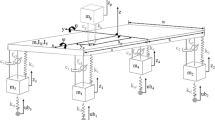Abstract
The current research of suspension performance evaluation is mixed in the evaluation of vehicle handling and ride comfort. However, it is lack of a direct and independent evaluation method for suspension performance. In this paper, a novel wheel turn center method is proposed to evaluate the suspension performance. This method is based on the concept and application of wheel turn center (WTC) and sprung mass turn center (SPTC). The vehicle body and each wheel are regarded to be independent rigid bodies and have their own turn centers which reflect respective steering motions and responses. Since the suspension is the link between vehicle body and wheels, the consistence between the sprung mass turn center and the wheel turn center reflects the effect and performance of the suspension system. Firstly, the concept and appropriate calculation method of WTC and SPTC are developed. Then the degree of inconsistence between WTC and SPTC and the time that they achieve consistence, when the vehicle experiences from transient steering to steady steering state, are proposed to evaluate suspension performance. The suspension evaluation tests are conducted under different vehicle velocities and lateral accelerations by using CarSim software. The simulation results show that the inconsistence of steering motion between vehicle body and wheels are mainly at high speeds and low lateral accelerations. Finally, based on the proposed evaluation indexes, the influences of different suspension characteristic parameters on suspension performance and their matches to improve steering coordination are discussed. The proposed wheel turn center method provides a guidance and potential application for suspension evaluation and optimization.
Similar content being viewed by others
References
GIAMPIERO M. Optimal design of complex mechanical systems with applications to vehicle engineering[M]. Springer, 2006.
LU X, LI H, PAPALAMBROS P. A design procedure for the optimization of vehicle suspensions[J]. International Journal of Vehicle Design, 1984, 5: 129–142.
CHOI B, YOOK S, CHOI D. The optimization of automotive suspension system considering multidisciplinary design requirements[R]. SAE Paper, 2009-01-1239, 2009.
SCHULLER J, HAQUE I, ECKEl M. An approach for optimization of vehicle handling behavior in simulation[J]. Vehicle System Dynamics, 2002, 37: 24–37.
HWANG JS, KIM S R. Design sensitivity analysis and optimization of McPherson suspension systems[C]//Proceedings of the World Congress on Engineering, London, UK, July 1–3, 2009: 978–998.
HWANG J S, KIM S R. Kinematic design of a double wishbone type front suspension mechanism using multi-objective optimization[C]//5th Australasian Congress on Applied Mechanics, Brisbane, Australia, December 10–12, 2007: 788–793.
HABIBI H, SHIRAZI K, SHISHESAZ M. Roll steer minimization of McPherson-strut suspension system using genetic algorithm method[J]. Mechanism and Machine Theory, 2008, 43: 57–67.
JIN Lingge. Studies on the design optimization method of suspension K&C characteristics of C-class vehicle[D]. Changchun: Jilin University, 2010.
PRANAVA S, HONG T K. Twist beam suspension design and analysis for vehicle handling and rollover behavior[R]. SAE Paper, 2010-01-0085, 2010.
YI Y, PARK J, HONG K. Design optimization of suspension kinematic and compliance characteristics[R]. SAE Paper, 2014-01-0394, 2014.
AHMADIAN M, AHN Y. On-vehicle evaluation of heavy truck suspension[R]. SAE Paper, 2003-01-3394, 2003.
YAMANAKAT, HOSHINOH, MOTOYMAK. Design optimization technique for suspension mechanism of automobile[C]//FISITA World Automotive Congress, June 12, Seoul, Korea, 2000: 1–5.
WANG Enrong, YING Liang, WANG Wanjun, et al. Semi-active control of vehicle suspension with magneto-rheological dampers Part I-controller synthesis and evaluation[J]. Chinese Journal of Mechanical Engineering, 2008, 21(1): 13–19.
WANG Enrong, YING Liang, WANG Wanjun, et al. Semi-active control of vehicle suspension with magneto-rheological dampers Part II-evaluation of suspension performance[J]. Chinese Journal of Mechanical Engineering, 2008, 21(2): 45–52.
BOURMISTROVA A, STOREY I, SUBIC A. Multiobjective optimisation of active and semi-active suspension systems with application of evolutionary algorithm[C]//International Conference on Modeling and Simulation, Melbourne, December 12–15, 2005: 1217–1223.
RAJAGOPAL K, PONNUSANNY L. Multi-objective optimization of vehicle active suspension system using debbo based PID controller[J]. International Journal of Engineering and Technology, 2014, 6(1): 252–262.
SEGEL L. Theoretical prediction and experimental substantiation of the response of the automobile to steering control[C]//Proceedings of the Institution of Mechanical Engineers: Automobile Division, 1956, 10(1): 310–330.
MITCHELL W C, STANIFORTH A, SCOTT I. Analysis of Ackermann steering geometry[R]. SAE Paper, 2006-01-3638, 2006.
AWREJCEWICZ J. Classical mechanics: kinematics and statics[M]. Springer, 2012.
MITSCHKE M. Vehicle system dynamics[M]. Springer, 2009.
THOMAS R K, PETERW L, DAVID A L. Spacecraft dynamics[M]. The Internet-First University Press, 2005.
WITTENBURG J. Dynamics of systems of rigid bodies[M]. Springer, 2008.
Author information
Authors and Affiliations
Corresponding author
Additional information
Supported by Changjiang Scholar and Innovative Research Team Plan of China (Grant No. IRT0626)
WANG Bo, born in 1987, is currently a PhD candidate at State Key Laboratory of Automobile Simulation and Control, Jilin University, China. His research interests include vehicle system dynamics and control.
GUAN Hsin, born in 1961, is currently a professor and a PhD candidate supervisor at State Key Laboratory of Automobile Simulation and Control, Jilin University, China. He received his PhD degree from Jilin University, China, in 1992. His research interests include vehicle dynamic simulation and control.
LU Pingping (Corresponding author), born in 1982, is currently a lecturer at Jilin University, China. She received her PhD degree from Jilin University, China, in 2012. Her research interests include vehicle dynamic simulation and control.
ZHAN Jun, born in 1973, is currently a professor and a PhD candidate supervisor at State Key Laboratory of Automotive Simulation and Control, Jilin University, China. His research interests include vehicle dynamic simulation and control.
Rights and permissions
About this article
Cite this article
Wang, B., Guan, H., Lu, P. et al. Novel evaluation method of vehicle suspension performance based on concept of wheel turn center. Chin. J. Mech. Eng. 28, 935–944 (2015). https://doi.org/10.3901/CJME.2015.0724.101
Received:
Revised:
Accepted:
Published:
Issue Date:
DOI: https://doi.org/10.3901/CJME.2015.0724.101




